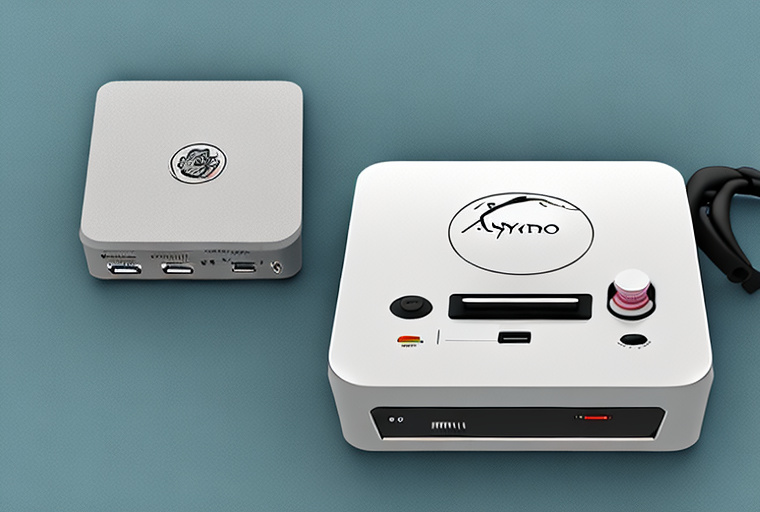The Ayaneo Retro Mini PC AM01 is an innovative device that combines style and functionality to deliver a unique computing experience. Inspired by the iconic design of the Macintosh computers, this mini PC offers a perfect blend of retro aesthetics and modern technology.
A Stylish Device Inspired by Macintosh Design
The Ayaneo Retro Mini PC AM01 takes its design cues from the classic Macintosh computers, known for their sleek and stylish appearance. With its compact form factor and retro color scheme, this device is a nostalgic trip down memory lane for any fan of vintage technology.
But don’t let its retro looks fool you – the Ayaneo Retro Mini PC AM01 is packed with powerful hardware that can handle your everyday computing tasks with ease. Equipped with the latest Intel Core processor and a solid-state drive, this mini PC delivers exceptional performance and fast boot times.
Whether you’re working on a creative project or simply browsing the internet, the Ayaneo Retro Mini PC AM01 ensures a smooth and responsive user experience. Its high-resolution display provides crisp visuals, while the integrated graphics card allows for seamless multitasking and smooth video playback.
Imagine yourself sitting at your desk, surrounded by the warm glow of a desk lamp, as you power up your Ayaneo Retro Mini PC AM01. The familiar sound of the startup chime fills the room, instantly transporting you back to a time when computers were just beginning to revolutionize the world.
As you navigate through the user-friendly interface, you can’t help but marvel at the attention to detail in the design. The sleek lines and retro color scheme evoke a sense of nostalgia, reminding you of the Macintosh computers that first captured your imagination all those years ago.
But this mini PC is not just about looks. It’s about performance. The latest Intel Core processor ensures that you can tackle even the most demanding tasks with ease. Whether you’re editing photos, creating music, or coding the next big software application, the Ayaneo Retro Mini PC AM01 has got you covered.
And let’s not forget about the solid-state drive. With its lightning-fast read and write speeds, you’ll never have to wait for your files to load again. Whether you’re accessing your favorite applications or opening large documents, everything happens in an instant.
But it’s not just about work. The Ayaneo Retro Mini PC AM01 is also perfect for entertainment. The high-resolution display brings your favorite movies and TV shows to life, with vibrant colors and sharp details. And thanks to the integrated graphics card, you can enjoy smooth video playback and immersive gaming experiences.
So whether you’re a professional looking for a powerful workstation or a casual user in search of a stylish and capable device, the Ayaneo Retro Mini PC AM01 is the perfect choice. It combines the timeless design of the Macintosh computers with the latest technology, giving you the best of both worlds.
Affordable Smart Home Sensors by Ikea
In recent years, the concept of a “smart home” has become increasingly popular. From voice-activated assistants to automated lighting systems, homeowners are embracing the convenience and efficiency of smart technology. Ikea, the Swedish furniture giant, has played a significant role in making smart home devices more accessible and affordable to the masses.
One of Ikea’s standout offerings in the smart home category is its range of affordable smart home sensors. These sensors can detect motion, temperature, light levels, and even open and close doors or windows. They work in conjunction with the Ikea Home Smart app, allowing users to control and monitor their smart home devices from anywhere.
What sets Ikea’s smart home sensors apart is their affordability and simplicity. Unlike many other smart home devices on the market, Ikea’s sensors are reasonably priced, making it easier for homeowners to upgrade their homes without breaking the bank. Additionally, the setup process is straightforward, making it accessible to users of all technical capabilities.
Imagine coming home after a long day at work, and as you approach your front door, the motion sensor detects your presence and automatically turns on the lights in your hallway. Not only does this provide a warm and welcoming atmosphere, but it also enhances safety by illuminating your path and deterring potential intruders.
But Ikea’s smart home sensors go beyond just motion detection. With the temperature sensor, you can ensure that your home is always at the perfect temperature. Whether you prefer a cozy warmth during the winter months or a refreshing coolness in the summer, the sensor can communicate with your thermostat to adjust the temperature accordingly. No more wasting energy or coming home to an uncomfortable environment.
Another impressive feature of Ikea’s smart home sensors is their ability to monitor light levels. This means that you can have your lights automatically dim or brighten depending on the natural light in the room. Say goodbye to constantly adjusting your lights throughout the day and hello to a more harmonious and energy-efficient living space.
Furthermore, Ikea’s smart home sensors can even keep track of whether your doors and windows are open or closed. This feature is not only useful for security purposes but also for energy conservation. If a window is left open, the sensor can send you an alert, reminding you to close it and prevent unnecessary heat loss or intrusion.
Whether you want to automate your lighting based on motion, receive alerts when a door is opened, or adjust your thermostat based on the ambient temperature, Ikea’s smart home sensors offer a cost-effective and user-friendly solution. With their affordability, simplicity, and wide range of capabilities, Ikea has truly made smart home technology accessible to everyone.
Popular Science Ends 151-Year Magazine Run
For over a century and a half, Popular Science has been a trusted source of scientific knowledge and discovery. Since its inception in 1872, the magazine has played a pivotal role in bringing groundbreaking scientific research and technological advancements to the masses. From the wonders of space exploration to the intricacies of the human body, Popular Science has captivated readers with its engaging content and informative articles.
However, after 151 years in print, the iconic magazine has announced that it will no longer publish a physical copy. This decision comes as no surprise in an era dominated by digital media. With the rise of online publications and the increasing popularity of e-books and e-readers, traditional magazines have struggled to compete for readership and advertising revenue.
But fear not, science enthusiasts! Popular Science’s digital presence remains strong. The magazine’s website continues to provide a wide range of thought-provoking articles, in-depth analyses, and captivating visuals. In this new digital era, Popular Science embraces the opportunity to reach an even wider audience and deliver scientific knowledge to anyone with an internet connection.
With a focus on current scientific breakthroughs, technological advancements, and environmental issues, Popular Science continues to inform and engage its readers in the digital age. The magazine’s online platform allows for more interactive content, including videos, infographics, and interactive simulations, enhancing the reader’s experience and making complex scientific concepts more accessible.
Moreover, Popular Science’s digital format enables readers to stay up-to-date with the latest scientific developments in real-time. With instant access to breaking news and emerging research, readers can delve into the world of science as it unfolds, without having to wait for the next issue to hit the stands.
Additionally, the magazine’s online presence fosters a sense of community among science enthusiasts. Through comment sections, forums, and social media platforms, readers can engage in discussions, share their thoughts, and connect with like-minded individuals from around the globe. This digital community not only enhances the reading experience but also promotes the exchange of ideas and the exploration of different perspectives.
As Popular Science bids farewell to its print edition, it embarks on an exciting new chapter in its long and illustrious history. The magazine’s commitment to delivering accurate, engaging, and accessible scientific content remains unwavering, as it continues to inspire curiosity, spark imagination, and promote a deeper understanding of the world we live in.
Google’s Plan to Remove Inactive Accounts
With the ever-increasing amount of personal data stored online, ensuring the security and privacy of user accounts has become a top priority for tech companies. Google, one of the world’s largest technology conglomerates, recently announced its plan to address this issue by removing inactive accounts.
Inactive accounts, also known as dormant accounts, are those that have been left unused for an extended period. These accounts can pose a potential security risk, as they may contain sensitive information that could be exploited by malicious actors.
In an effort to enhance account security and protect user privacy, Google has introduced an account activity policy that will automatically delete inactive accounts after a certain period of inactivity. This policy aims to ensure that only active and regularly monitored accounts remain on Google’s servers.
While this move by Google is undoubtedly a step in the right direction, it does raise some concerns among users who may have legitimate reasons for not using their Google accounts regularly. To address these concerns, Google has implemented measures to notify users in advance about the deletion of their inactive accounts and provide options for account reactivation.
By removing inactive accounts, Google aims to streamline its services, improve account security, and protect user privacy. As users, it is essential to stay informed about these changes and take proactive steps to maintain the security of our online accounts.




